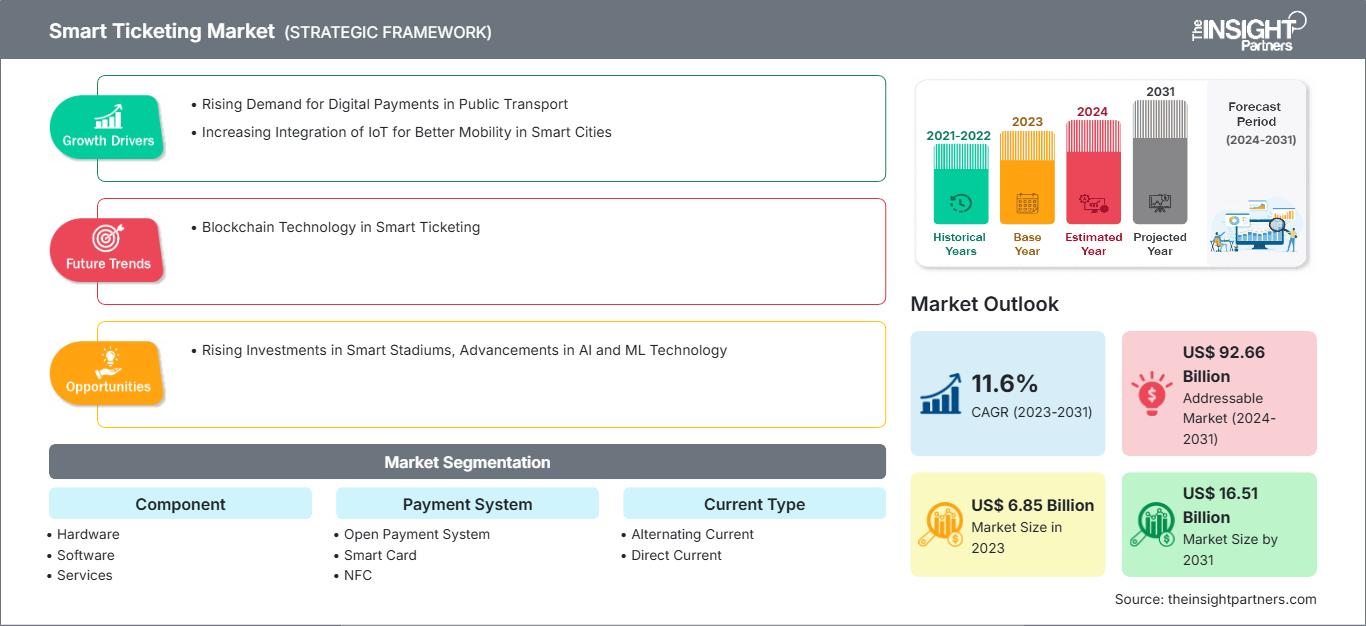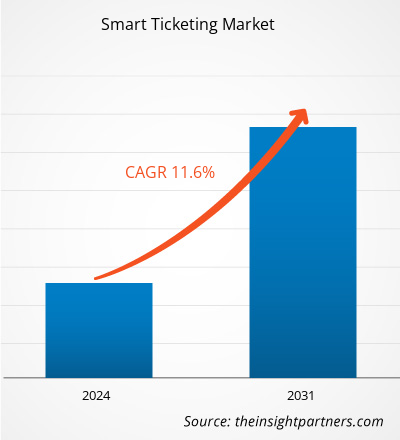智能票务市场规模预计将从 2023 年的 68.5 亿美元增至 2031 年的 165.1 亿美元。预计 2023 年至 2031 年期间的复合年增长率将达到 11.6%。智能票务中的区块链技术有望为市场带来新的趋势。
智能票务市场分析
近年来,智能票务市场取得了显著增长。各行各业快速数字化等因素导致对非接触式支付的依赖性日益增强。此外,全球范围内越来越多地采用智能设备订票,预计这也将促进智能票务市场规模的增长。此外,人工智能、虚拟现实地图、智能手机和可穿戴设备等先进技术与票务系统的融合,预计将在未来几年引领智能票务市场的新趋势。
智能票务市场概览
将旅行票以电子方式存储在微芯片(通常嵌入智能卡)上的过程称为智能票务。使用ITSO智能卡将取代传统的现金支付和纸质车票,使公共交通用户能够轻松上下公交车、电车或火车。为了授权出行,交通运营商使用静态售票机或手持售票机在闸机处扫描非接触式智能卡。随着人们对票务流程数字化的日益重视,智能票务作为传统纸质车票的现代替代品,已获得显著发展。这项创新技术无需排队购票,节省了乘客的时间。它还发展到涵盖智能卡和移动应用程序,为纸质车票提供了更优越的替代方案。此外,智能票务广泛应用于各种交通方式,并在体育和娱乐活动中的应用也日益增多。一个显著的例子是里约热内卢,该市举办了奥运会,预计将迎来50万国际游客。该市的公共交通票务系统采用了金雅拓的非接触式技术,包括防水的“Celego非接触式腕带”和“Celego非接触式贴纸”,均嵌入了金雅拓的非接触式芯片,并获得了Visa和万事达卡的认证。这些解决方案只需在非接触式读卡器附近轻轻一挥腕带即可激活,代表着在全球范围内引入的一项重大基础设施升级。
自定义此报告以满足您的要求
您将免费获得任何报告的定制,包括本报告的部分内容,或国家级分析、Excel 数据包,以及为初创企业和大学提供超值优惠和折扣
智能票务市场: 战略洞察

- 获取本报告的主要市场趋势。这个免费样本将包括数据分析,从市场趋势到估计和预测。
您将免费获得任何报告的定制,包括本报告的部分内容,或国家级分析、Excel 数据包,以及为初创企业和大学提供超值优惠和折扣
智能票务市场: 战略洞察

- 获取本报告的主要市场趋势。这个免费样本将包括数据分析,从市场趋势到估计和预测。
智能票务市场驱动力与机遇
公共交通数字支付需求不断增长
现代城市提供多种交通选择,例如公交车、火车和地铁。每个公共交通系统都有各自的票务系统。管理不同交通方式的多张智能卡或应用程序可能会让通勤者感到不知所措。需要一种集中式方法来整合所有交通网络。朝着这个方向,世界各地的公共交通基础设施正在进行升级。升级还旨在通过无缝支付界面改善通勤体验。例如,2023年5月,全球智能出行技术解决方案提供商、Conduent Incorporated(纳斯达克股票代码:CNDT)的业务部门Conduent Transportation宣布,其子公司(Conduent和Convergint的合资公司)已被澳大利亚维多利亚州选中,负责提供该州下一代公共交通票务系统myki。两家公司旨在实施一套先进的、基于非接触式支付账户的交通票务系统,该系统将升级该州现有的智能卡解决方案,并为乘客提供更佳的用户体验。2022年12月,日立铁路的360Pass出行平台在意大利特伦蒂诺正式上线,乘客无需购买传统车票即可乘坐该市所有公共交通工具。该应用程序可在任何应用商店免费下载。市民和游客下载应用程序后,即可使用智能手机轻松购买多式联运车票。随着城市向智能化、互联化和数字化优先的环境发展,公共交通服务的数字支付仍将占据重要地位,从而推动智能票务市场的增长。
智能体育场馆投资不断增长
近年来,全球对非接触式体验系统的需求加速了智能票务在体育场馆和活动销售流程中的应用。智能票务为体育场馆和活动组织者提供了一种更便捷的方式,使其能够更高效地运营,避免管理成本和流程瓶颈。这一点至关重要,因为传统的纸质票务需要耗费更多的人力和资源,是一种不可持续的体育赛事组织方式。智能票务系统的实施可以显著提高门票销量,因为球迷可以查看自己喜欢的座位是否还有剩余,并根据自己的喜好订购门票。从这些预订中获得的重要数据使组织者能够确定球迷最感兴趣的区域,从而制定针对特定受众群体的有针对性的票务策略。智能票务负责票务验证后,体育场工作人员可以重新分配,以改善球迷体验、协助人群管理、提供信息和指导,或支持需要人工干预的关键区域。智能票务通过简化票务操作,最大限度地利用了工作人员,提高了运营效率,也提升了观众的整体体育场体验。例如,在 2013 年国际足联联合会杯、2014 年国际足联世界杯、2017 年国际足联联合会杯、2018 年国际足联世界杯、2021 年国际足联阿拉伯杯和 2022 年卡塔尔国际足联世界杯期间,数百万球迷使用了 RFID 门票。国际足联已指定 HID 为其官方门票生产商。因此,加大对智能体育场馆的投资,使用户支付体验更加无缝衔接,预计将为智能票务市场扩张创造丰厚的商机。
智能票务市场报告细分分析
促成智能票务市场分析的关键细分领域是组件、支付系统和最终用户。
- 基于组件,市场细分为硬件、软件和服务。 2023 年,硬件部分占据了最大的市场份额。
- 按支付系统划分,市场分为开放支付系统、智能卡和 NFC。2023 年,智能卡部分占据了最大的市场份额。
- 就最终用户而言,市场分为交通运输、体育和娱乐、停车和其他。2023 年,体育和娱乐部分占据了市场主导地位。
按地区划分的智能票务市场份额分析
智能票务市场报告的地理范围主要分为五个区域:北美、亚太地区、欧洲、中东和非洲以及南美和中美洲。
2023 年,北美占据了相当大的市场份额。由于智能票务系统中使用的智能卡技术的进步,北美智能票务市场正在经历显着增长。智能手机和尖端可穿戴设备带来的非接触式解决方案正获得显著发展,因为这些解决方案有助于优化时间,并通过灵活的支付方式减少实体售票柜台的摩擦。三星等知名智能可穿戴设备制造商已在其智能手表中引入了支付功能。此外,大多数设备制造商正在将包括三星支付、Fitbit Pay、Apple Pay、Garmin Pay 和 Google Pay 在内的支付服务集成到他们的移动钱包产品中。虽然智能手表支付仍处于发展阶段,但它们拥有巨大的市场潜力。这些发展预计将使消费者能够使用可穿戴设备购票,这反映了票务格局的显著转变。此外,Cubic Corporation 等主要智能票务市场参与者采取的举措也对市场产生了积极影响。例如,2023 年 5 月,英飞凌的 CALYPSO 举措促进了遵循开放标准的可互操作票务解决方案的开发,使制造商能够根据交通运营商和政府部门的独特需求定制解决方案。这种方法消除了对磁条、条形码和专有车票的依赖,确保了在不同系统之间更高的灵活性和兼容性。这一进展代表着全州非接触式票务系统的现代化和扩展迈出了重要一步,并计划在整个铁路客运系统中全面部署,随后还将扩展到公交车和渡轮。
智能票务智能票务市场区域洞察
The Insight Partners 的分析师已详尽阐述了预测期内影响智能票务市场的区域趋势和因素。本节还探讨了北美、欧洲、亚太地区、中东和非洲以及南美和中美洲的智能票务市场细分和地域分布。
智能票务市场报告范围
| 报告属性 | 细节 |
|---|---|
| 市场规模 2023 | US$ 6.85 Billion |
| 市场规模 2031 | US$ 16.51 Billion |
| 全球复合年增长率 (2023 - 2031) | 11.6% |
| 历史数据 | 2021-2022 |
| 预测期 | 2024-2031 |
| 涵盖的领域 |
By 组件
|
| 覆盖地区和国家 | 北美
|
| 市场领导者和主要公司简介 |
|
智能票务市场参与者密度:了解其对业务动态的影响
智能票务市场正在快速增长,这得益于终端用户需求的不断增长,而这些需求的驱动因素包括消费者偏好的不断变化、技术进步以及对产品优势的认知度不断提高。随着需求的增长,企业正在扩展其产品线,不断创新以满足消费者需求,并抓住新兴趋势,从而进一步推动市场增长。

- 获取 智能票务市场 主要参与者概述
智能票务市场新闻及最新发展
智能票务市场的评估是通过收集一手和二手研究的定性和定量数据进行的,这些数据包括重要的企业出版物、协会数据和数据库。以下列出了智能票务市场的一些发展:
- 英飞凌的 CALYPSO 举措促进了符合开放标准的可互操作票务解决方案的开发,使制造商能够根据交通运营商和政府部门的独特需求定制解决方案。这种方法消除了对磁条、条形码和专有票证的依赖,确保了在不同系统之间更高的灵活性和兼容性。(来源:英飞凌,新闻稿,2023 年 5 月)
- 恩智浦半导体推出了其 MIFARE Ultralight 系列的最新成员,被誉为最安全的版本。 MIFARE Ultralight AES 利用标准 AES 身份验证并拥有通用标准 EAL3+ 安全认证,为有限使用的非接触式票证、RFID 基本宾客卡和类似应用提供增强的隐私和安全性。 (来源:恩智浦半导体,新闻稿,2022 年 2 月)
智能票务市场报告覆盖范围和可交付成果
《智能票务市场规模和预测(2021-2031)》报告对市场进行了详细的分析,涵盖以下领域:
- 智能票务市场规模以及涵盖范围内所有关键细分市场的全球、区域和国家/地区预测
- 智能票务市场趋势以及市场动态,例如驱动因素、限制因素和关键机遇
- 详细的 PEST 和 SWOT 分析
- 智能票务市场分析涵盖关键市场趋势、全球和区域框架、主要参与者、法规和最新市场发展
- 行业格局和竞争分析涵盖市场集中度、热图分析、知名参与者和智能票务市场的最新发展
- 详细的公司简介
- 历史分析(2 年)、基准年、预测(7 年)及复合年增长率
- PEST和SWOT分析
- 市场规模、价值/数量 - 全球、区域、国家
- 行业和竞争格局
- Excel 数据集
近期报告
客户评价
购买理由
- 明智的决策
- 了解市场动态
- 竞争分析
- 客户洞察
- 市场预测
- 风险规避
- 战略规划
- 投资论证
- 识别新兴市场
- 优化营销策略
- 提升运营效率
- 顺应监管趋势




















 获取免费样品 - 智能票务市场
获取免费样品 - 智能票务市场